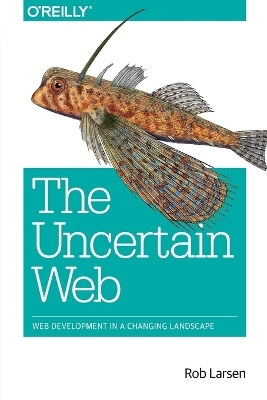
The Uncertain Web
O'Reilly Media (Verlag)
978-1-4919-4590-2 (ISBN)
What’s the best way to develop for a Web gone wild? That’s easy. Simply scrap the rules you’ve relied on all these years and embrace uncertainty as a core tenet of design. In this practical book, veteran developer Rob Larsen outlines the principles out what he calls The Uncertain Web, and shows you techniques necessary to successfully make the transition.
By combining web standards, progressive enhancement, an iterative approach to design and development, and a desire to question the status quo, your team can create sites and applications that will perform well in a wide range of present and future devices. This guide points the way.
Topics include:
- Navigating thousands of browser/device/OS combinations
- Focusing on optimal, not absolute solutions
- Feature detection, Modernizr, and polyfills
- RWD, mobile first, and progressive enhancement
- UIs that work with multiple user input modes
- Image optimization, SVG, and server-side options
- The horribly complex world of web video
- The Web we want to see in the future
Rob Larsen has spent 13 years building web sites and applications for some of the world's biggest brands. He applied that experience to teaching a broad audience in Beginning HTML and CSS.
Chapter 1Embracing Uncertainty
Embrace Uncertainty
From Microsoft’s Monoculture to Today’s Healthy Chaos
Where We Are Right Now
Chapter 2Navigating the Uncertain Web
Don’t Blame the Web for Being the Web
Identify and Embrace Your Audience
Test and Pray for the Best
Focus on Optimal, Not Absolute Solutions
Embrace Accessibility
Lose Your Technology Biases
Lose Your Stack Biases
Keep at Least One Eye on the Cutting Edge
Spread Your Wings (and Question Your Assumptions)
Chapter 3Lay a Foundation for the Future with Feature Detection and Polyfills
Feature Detection
Using Modernizr
“Frontend Development Done Right”
Chapter 4Selecting Responsive Design or Another Mobile Experience
Boston Globe’s RWD Redesign
Really? RWD for Every Site?
Mobile First, RESS, and the Rest of the Mobile Development Universe
Choosing a Development Path
Redirects Should Resolve Logically
Redirect Options
Always Offer an Escape from the Mobile Version
Be Fluid and Design for Your Design
“Accepting the Ebb and Flow of Things”
Chapter 5Working with User Input
The State of User Input on the Web
What It Means to Get It Wrong
Design for a Spectrum of Potential User Inputs
Working with the Full User Input Spectrum
Assume Nothing and Accommodate Everyone
Chapter 6The Surprisingly Complex World of Images on the Web
While We Weren’t Paying Attention, Images Got Complicated
Optimizing Images for the Web
Responsive Images
Embrace SVG
On the Server Side
A Practical Developers Guide to All of This Complexity
Conclusion
Chapter 7The Horribly Complex World of Web Video
The Core Technology
Letting the Pros Handle It
Make the Best of a Complicated Situation
Chapter 8The Web We Want
Things Can Get Better (But They Do Occasionally Get Worse)
Let’s Push Things Forward
The Web We Want Starts with Us
| Erscheint lt. Verlag | 13.1.2015 |
|---|---|
| Verlagsort | Sebastopol |
| Sprache | englisch |
| Maße | 162 x 228 mm |
| Gewicht | 336 g |
| Einbandart | Paperback |
| Themenwelt | Mathematik / Informatik ► Informatik ► Theorie / Studium |
| Informatik ► Web / Internet ► Web Design / Usability | |
| Schlagworte | Webdesign |
| ISBN-10 | 1-4919-4590-7 / 1491945907 |
| ISBN-13 | 978-1-4919-4590-2 / 9781491945902 |
| Zustand | Neuware |
| Haben Sie eine Frage zum Produkt? |
aus dem Bereich


